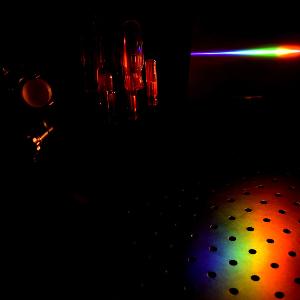How significant is radiative heat transport at core-mantle boundary?
How significant is radiative heat transport at the core-mantle boundary?

How significant is radiative heat transport at the core-mantle boundary?

We propose to use the new spectroscopic capabilities at the German Research Centre for Geosciences (GFZ) to quantify the radiative thermal conductivity of bridgmanite and post-perovskite at the core-mantle boundary (CMB) pressure-temperature conditions. Our results will help constrain heat flux patterns across the CMB, which is a key to linking deep mantle structures, their dynamics, and geodynamo. Bridgmanite, Earth’s most abundant mineral, undergoes a phase transition to post-perovskite at near CMB pressure-temperature conditions. The distribution of these two phases above the CMB and their physical properties thus largely determine the properties of the lowermost mantle. In particular, the contrasting thermal conductivities of bridgmanite and post-perovskite, as suggested by some earlier studies, may produce lateral variations in heat fluxes out of the core, which in turn affect core and mantle dynamics. Unravelling the distribution of bridgmanite and post-perovskite near the CMB as well as reliable constraints on their thermal conductivity are essential for mapping heat fluxes out of the core. Many questions remain, however, about the efficiency of various microscopic heat transfer mechanisms at the base of the mantle. A particularly large unknown is the contribution of radiative thermal conductivity to the total thermal conductivity at the CMB. Available estimates of radiative thermal conductivity at the CMB conditions differ by a factor of ~35: from insignificant to dominant. Resolving the controversy about the efficiency of radiative heat transport in the lowermost mantle is thus an important step towards quantifying heat fluxes out of the core, and is the primary research goal of this proposal. Here we propose to measure the optical absorption coefficients of bridgmanite and post-perovskite of variable chemical compositions at the CMB pressure-temperature conditions. Most previous studies of the radiative thermal conductivity at the CMB explored the effect of only pressure on the optical properties of mantle minerals. The few high-pressure high-temperature studies were also inconclusive, likely due to the use of samples with different chemical compositions. In the proposed work we will capitalize on the recent technical developments at the GFZ that allow probing optical properties at realistic CMB conditions as well as on our collection of chemically-diverse samples and precursors. By combining mineralogical models of the lowermost mantle and its thermal conductivity enabled in part by DFG SPP DeepDyn, we will quantify plausible heat fluxes out of the core. These can serve as direct input into geodynamic models of the Earth’s mantle and core as well as to validate their independent outcome. As such, the proposed work helps bridge seismic, mineral physics, and geodynamic studies of the deep Earth and is essential for DeepDyn.